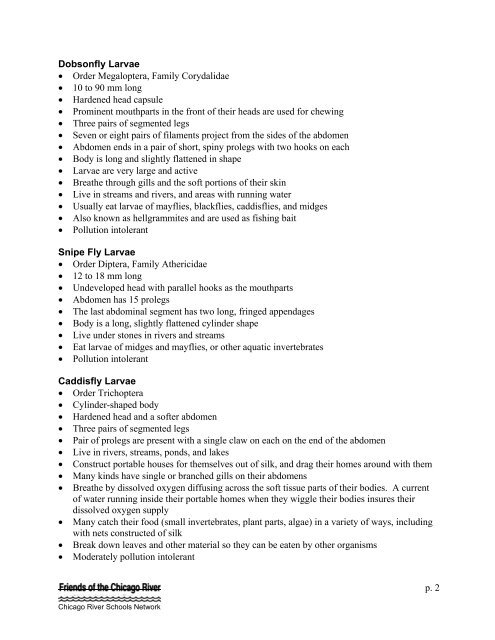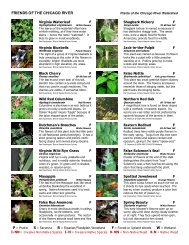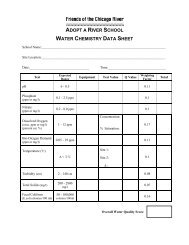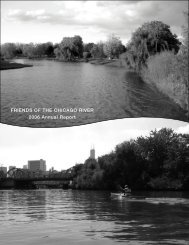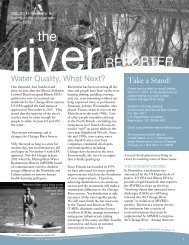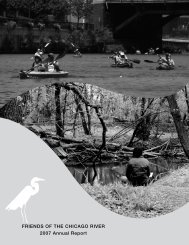Macroinvertebrate Fact Sheet - Friends of the Chicago River
Macroinvertebrate Fact Sheet - Friends of the Chicago River
Macroinvertebrate Fact Sheet - Friends of the Chicago River
You also want an ePaper? Increase the reach of your titles
YUMPU automatically turns print PDFs into web optimized ePapers that Google loves.
Dobsonfly Larvae<br />
• Order Megaloptera, Family Corydalidae<br />
• 10 to 90 mm long<br />
• Hardened head capsule<br />
• Prominent mouthparts in <strong>the</strong> front <strong>of</strong> <strong>the</strong>ir heads are used for chewing<br />
• Three pairs <strong>of</strong> segmented legs<br />
• Seven or eight pairs <strong>of</strong> filaments project from <strong>the</strong> sides <strong>of</strong> <strong>the</strong> abdomen<br />
• Abdomen ends in a pair <strong>of</strong> short, spiny prolegs with two hooks on each<br />
• Body is long and slightly flattened in shape<br />
• Larvae are very large and active<br />
• Brea<strong>the</strong> through gills and <strong>the</strong> s<strong>of</strong>t portions <strong>of</strong> <strong>the</strong>ir skin<br />
• Live in streams and rivers, and areas with running water<br />
• Usually eat larvae <strong>of</strong> mayflies, blackflies, caddisflies, and midges<br />
• Also known as hellgrammites and are used as fishing bait<br />
• Pollution intolerant<br />
Snipe Fly Larvae<br />
• Order Diptera, Family A<strong>the</strong>ricidae<br />
• 12 to 18 mm long<br />
• Undeveloped head with parallel hooks as <strong>the</strong> mouthparts<br />
• Abdomen has 15 prolegs<br />
• The last abdominal segment has two long, fringed appendages<br />
• Body is a long, slightly flattened cylinder shape<br />
• Live under stones in rivers and streams<br />
• Eat larvae <strong>of</strong> midges and mayflies, or o<strong>the</strong>r aquatic invertebrates<br />
• Pollution intolerant<br />
Caddisfly Larvae<br />
• Order Trichoptera<br />
• Cylinder-shaped body<br />
• Hardened head and a s<strong>of</strong>ter abdomen<br />
• Three pairs <strong>of</strong> segmented legs<br />
• Pair <strong>of</strong> prolegs are present with a single claw on each on <strong>the</strong> end <strong>of</strong> <strong>the</strong> abdomen<br />
• Live in rivers, streams, ponds, and lakes<br />
• Construct portable houses for <strong>the</strong>mselves out <strong>of</strong> silk, and drag <strong>the</strong>ir homes around with <strong>the</strong>m<br />
• Many kinds have single or branched gills on <strong>the</strong>ir abdomens<br />
• Brea<strong>the</strong> by dissolved oxygen diffusing across <strong>the</strong> s<strong>of</strong>t tissue parts <strong>of</strong> <strong>the</strong>ir bodies. A current<br />
<strong>of</strong> water running inside <strong>the</strong>ir portable homes when <strong>the</strong>y wiggle <strong>the</strong>ir bodies insures <strong>the</strong>ir<br />
dissolved oxygen supply<br />
• Many catch <strong>the</strong>ir food (small invertebrates, plant parts, algae) in a variety <strong>of</strong> ways, including<br />
with nets constructed <strong>of</strong> silk<br />
• Break down leaves and o<strong>the</strong>r material so <strong>the</strong>y can be eaten by o<strong>the</strong>r organisms<br />
• Moderately pollution intolerant<br />
<strong>Chicago</strong> <strong>River</strong> Schools Network<br />
p. 2


